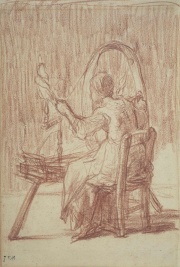Difference between revisions of "Conte crayon"
| (8 intermediate revisions by 3 users not shown) | |||
| Line 1: | Line 1: | ||
| − | [[File:13.472-SC31205.jpg|thumb|]] | + | [[File:13.472-SC31205.jpg|thumb|Francoise Millet<br>MFA# 13.472]] |
== Description == | == Description == | ||
| − | A former brand name for a hard, square-shaped, | + | A former brand name for a hard, square-shaped, drawing stick. Conté crayons were developed by Nicholas Jacques Conté just before the turn of the 19th century. Originally the wood-encased crayons contained graphite and clay (see [[graphite pencil]]). Soon after other pigments, such as lamp black, sepia and chalk were added for color variations. Currently, small amounts of organic binders, such as fatty oils, are added to some Conté crayons giving them a slightly greasy feel. Conté crayons produce produce a thick dense line. They have been used for lithography and artistic drawings. Since the lines abrade and smear readily, they are often sprayed with a fixative. |
| − | [[File:63.141-SC31231.jpg|thumb|]] | + | [[File:63.141-SC31231.jpg|thumb|Jean-Francoise Millet<br>MFA# 63.141]] |
== Synonyms and Related Terms == | == Synonyms and Related Terms == | ||
| − | + | Conté crayon; crayon conté (Fr.) | |
| − | |||
| − | |||
| − | |||
| − | |||
== Comparisons == | == Comparisons == | ||
[[media:download_file_550.pdf|Websites of pastel, pencil, and marker manufacturers]] | [[media:download_file_550.pdf|Websites of pastel, pencil, and marker manufacturers]] | ||
| − | |||
| − | |||
| − | |||
| − | |||
== Additional Images == | == Additional Images == | ||
<gallery> | <gallery> | ||
| − | File:Conte_crayon_gen3.jpg| | + | File:Conte_crayon_gen3.jpg|Conte crayon |
File:Fab. Red Conte Crayon 500x.jpg|Fabricated red conte crayon | File:Fab. Red Conte Crayon 500x.jpg|Fabricated red conte crayon | ||
</gallery> | </gallery> | ||
| + | == Resources and Citations == | ||
| + | * H.Stratis, "Conté Crayon" in ''Media & Techniques of Works of Art on Paper'', New York University, 1999 | ||
| − | + | * Ralph Mayer, ''A Dictionary of Art Terms and Techniques'', Harper and Row Publishers, New York, 1969 (also 1945 printing) | |
| − | |||
| − | * | ||
| − | * | + | * Kurt Wehlte, ''The Materials and Techniques of Painting'', Van Nostrand Reinhold Co., New York, 1975 |
* ''A Glossary of Paper Conservation Terms'', Margaret Ellis (ed.), Conservation Center of the Institute of Fine Arts, New York City, 1998 | * ''A Glossary of Paper Conservation Terms'', Margaret Ellis (ed.), Conservation Center of the Institute of Fine Arts, New York City, 1998 | ||
Latest revision as of 11:04, 7 August 2020
Description
A former brand name for a hard, square-shaped, drawing stick. Conté crayons were developed by Nicholas Jacques Conté just before the turn of the 19th century. Originally the wood-encased crayons contained graphite and clay (see Graphite pencil). Soon after other pigments, such as lamp black, sepia and chalk were added for color variations. Currently, small amounts of organic binders, such as fatty oils, are added to some Conté crayons giving them a slightly greasy feel. Conté crayons produce produce a thick dense line. They have been used for lithography and artistic drawings. Since the lines abrade and smear readily, they are often sprayed with a fixative.
Synonyms and Related Terms
Conté crayon; crayon conté (Fr.)
Comparisons
Websites of pastel, pencil, and marker manufacturers
Additional Images
Resources and Citations
- H.Stratis, "Conté Crayon" in Media & Techniques of Works of Art on Paper, New York University, 1999
- Ralph Mayer, A Dictionary of Art Terms and Techniques, Harper and Row Publishers, New York, 1969 (also 1945 printing)
- Kurt Wehlte, The Materials and Techniques of Painting, Van Nostrand Reinhold Co., New York, 1975
- A Glossary of Paper Conservation Terms, Margaret Ellis (ed.), Conservation Center of the Institute of Fine Arts, New York City, 1998



